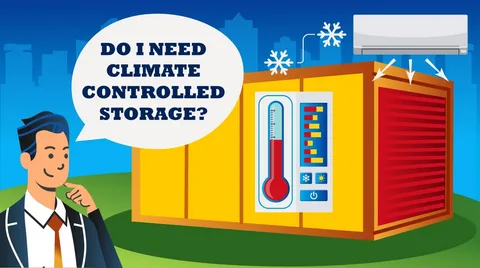Paper may look simple, but the conditions around it decide how long it survives. Ink fades, fibers break down, and data integrity weakens when storage environments fluctuate. For companies preserving contracts, legal records, or historical files, selecting the right space is not a luxury—it becomes an insurance policy for the business itself.
Understanding the Benefits of Climate Control for Business Archives
Climate-regulated environments deliver stability, which is the single biggest advantage for document preservation. Unlike standard units that change temperature with the seasons, climate controlled storage stays within a narrow and predictable range. This protects paper fibers, prevents warping in boxed files, and shields ink or toner from breaking down due to heat exposure.
Consistency matters more than low or high temperature alone. A storage space that swings from cold to warm repeatedly creates microscopic condensation inside boxes. Over long periods, that moisture transfer weakens paper, encourages brittleness, and leads to information loss. Climate regulation removes that recurring stress, keeping archived materials closer to their original condition for longer.
How Climate-controlled Storage Protects Sensitive Business Documents
Sensitive documents degrade quietly. By the time visible damage appears, the loss is often permanent. Controlled environments curb yellowing, prevent adhesive failure on labels, and stop folder tabs from curling or cracking. They also protect inks used on transaction records, blueprints, or printed signatures that must remain legible for compliance or legal use.
Another quiet but important layer of protection is defense against mold spores. Mold doesn’t require flooding to form—it thrives in enclosed spaces where air holds too much moisture for long periods. Regulated storage limits that condition entirely. Documents kept in optimized air quality remain clean, readable, and legally defensible years beyond what uncontrolled storage allows.
Factors to Consider When Choosing Storage for Important Records
The size of the unit matters less than the environment inside it. The right storage option balances constant temperature, sealed structure, airflow management, and low ambient humidity. Proximity and access hours also play a role, but only after environmental conditions check out.
Security cannot be overlooked either. Archived records often include data that is confidential, regulated, or tied to intellectual property. Cameras, controlled entry points, and individual unit locks add protection against unauthorized access. Companies searching for storage units near me gain more value when these safeguards operate alongside climate stability, not in place of it.
The Role of Temperature and Humidity in Preserving Business Archives
Ideal temperature ranges slow the natural aging process of paper. Heat accelerates chemical reactions in organic materials, including the breakdown of cellulose—the primary component of paper. The warmer the environment, the faster documents degrade, even when untouched or neatly packed. Humidity amplifies the problem in a different way. Excess moisture causes pages to ripple, staples to rust, and boxed documents to absorb dampness from the air. It also softens adhesive on labels, envelopes, and binding materials. Maintaining balanced humidity keeps boxes structurally sound, pages flat, and document integrity intact, year after year.
Why Traditional Storage Might Not Be Enough for Business Documents
Standard storage units are built to hold items, not preserve them. They provide walls and a lock, but little defense against seasonal weather changes. In summer, internal temperatures can climb to levels that dry and weaken paper. In winter, cold air traps moisture that resurfaces during warm-up periods, forming a damaging moisture cycle.
Air quality adds another hidden variable. Dust, pollen, and unfiltered airflow circulate freely in non-regulated storage spaces. These particles settle inside boxes and file edges. Over time they create buildup that attracts humidity and speeds deterioration. Regular storage protects belongings from theft—but not from time.
Comparing Climate-controlled and Regular Storage for Business Use
The difference shows up most clearly in longevity. Regular units may be more economical on day one, but the cost advantage fades if records degrade or require restoration, replacement, or scanning recovery later. Climate regulated spaces preserve readability without the added expense of document remediation. Access behavior also shifts. Businesses using traditional storage often avoid frequent visits, not because of security, but because high or low indoor temperatures make the space uncomfortable to work in for long. Climate regulation creates a practical work environment for organizing, retrieving, or auditing boxes without rushing or risking document exposure to harsh conditions during handling.
The Long-term Value of Climate-controlled Storage for Business Archives
Climate-controlled environments deliver compound benefits. Documents stay usable longer, retrieval becomes less stressful, and businesses retain proof of records that might be needed for audits, legal disputes, licensing, or historical reference. This level of protection also supports digital backup strategies, since scanning operations require pages that emerge clean, flat, and intact.
For organizations holding files that cannot afford to fade, tear, or mildew, long-term storage isn’t a space decision—it’s a preservation strategy. Companies who need secure, consistent environments with monitored conditions often look for nearby options that balance protection and access. A facility offering dependable archival conditions can be found through Storage Partner when searching for solutions that go beyond ordinary storage.


